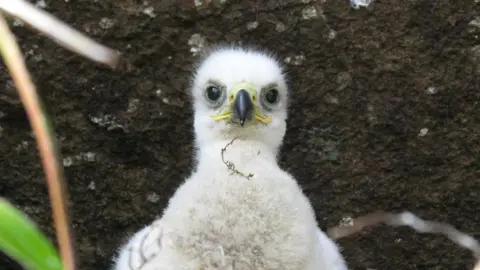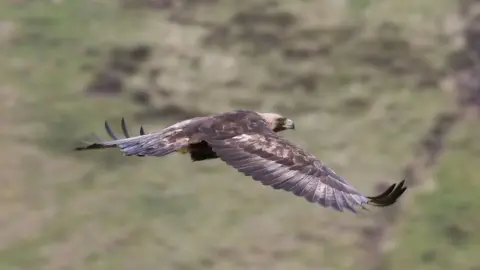Golden eagle genome study 'a conservation game changer'
British scientists have made a breakthrough that could help safeguard the future of one of the world's most admired birds - the golden eagle.
The majestic king of birds is under threat in some areas, but a study led by the Wellcome Sanger Institute could help them return to those spots.
The work to unravel their genetic code is part of a mission to sequence 25 new genomes of UK species.
One of the team described the development as a "real game changer".
What is a genome and how could it be useful?
 SPL
SPL"We're all made of the same four letters of code," explained Julia Wilson, association director of the Wellcome Sanger Institute. "It's a blueprint written in your DNA - half comes from your mum and half comes from your dad.
"That makes you uniquely you.
"But it's just the way those letters are arranged that makes you a human - or an eagle."
Scientists selected the golden eagle to have its genome sequenced - to have every letter of its code read and recorded - because of the value of that genetic information to conserve the birds.
Dr Rob Ogden, a conservation biologist from Edinburgh University's Roslin Institute, who was a lead scientist in the project, explained that this "blueprint for life" would support the management of the species - even helping conservationists to bring back eagles to areas where they have disappeared.
"Having a whole genome for any species is a real game changer," he said. "It opens up a huge amount of potential research - everything from looking at the health of the bird to the ecology, to how it reproduces - and so this is the beginning of a much bigger journey into golden eagle biology.
"In future, we want to be able to screen wild birds to select the best birds to move around."
 Iain Erskine
Iain ErskineHow endangered are golden eagles?
The great raptors are found around the globe - in North America, Europe and Asia. But in some countries populations are small and declining. As an apex predator - at the top of the food chain - these birds of prey are essential to their environment.
"In the UK, they're an endangered species," explained Dr Wilson. "There are many projects to try to conserve it, understand its biology and some of this information can be gleaned from having the genome of this species."
Scientists in Japan are already using the genome to understand more about the diversity of the birds there - where the population is under threat and in decline. In the future, the genome could even provide a biological template to work out which birds from elsewhere in the world might be candidates to reinforce the Japanese population.
Where can you see wild eagles?
 Iain Erskine
Iain ErskineAlmost all of those in the UK are found only in the highlands and islands of Scotland.
Dave Sexton, the RSPB's conservation officer on the Isle of Mull, monitors and helps protect the eagles nesting on the island. But even with his encyclopaedic knowledge, the birds can be hard to find.
"If it rains, they'll just find a sheltered crag and just sit it out - and that can last for days in the winter," he said.
Illegal persecution - shooting and poisoning of the birds - is still a threat to the species.
"It's important to know enough about their biology and habitat and food requirements, so we can protect habitats and designate special protection areas," Mr Sexton explained.
"It would be a terrible loss if they weren't here. They represent the free spirit of these hills and glens.
"They nest on the highest crag in the most inaccessible area - they're symbols of these wild places, and we need to make sure we protect them for the future."
